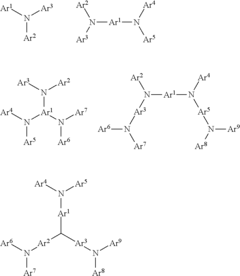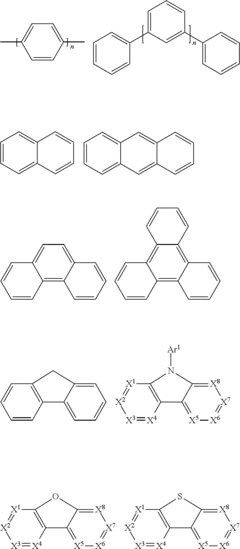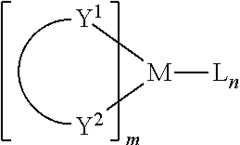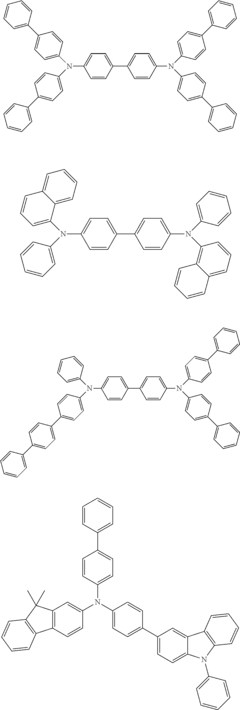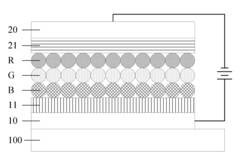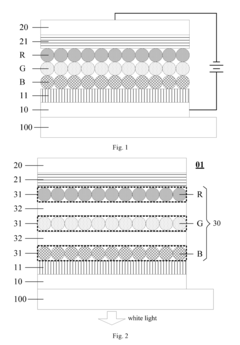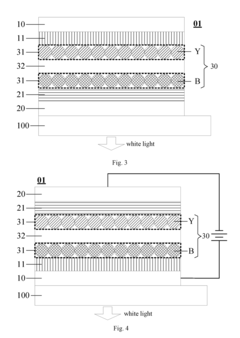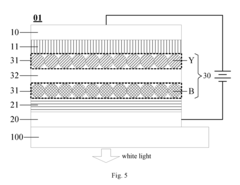QLED Displays: Pioneering Green Technology in Displays
JUN 19, 20259 MIN READ
Generate Your Research Report Instantly with AI Agent
Patsnap Eureka helps you evaluate technical feasibility & market potential.
QLED Evolution & Objectives
Quantum Dot Light Emitting Diode (QLED) technology has emerged as a revolutionary advancement in display technology, offering superior color performance and energy efficiency. The evolution of QLED displays can be traced back to the early 2000s when researchers first began exploring the potential of quantum dots in light-emitting applications. Since then, QLED technology has undergone significant improvements, leading to its current status as a leading contender in the green display technology arena.
The primary objective of QLED technology is to provide an environmentally friendly alternative to traditional display technologies while delivering exceptional visual quality. This goal aligns with the growing global emphasis on sustainable technologies and reduced energy consumption. QLED displays aim to achieve this by leveraging the unique properties of quantum dots, which offer precise color control and high energy efficiency.
As the technology has progressed, several key milestones have marked its evolution. Early QLED prototypes faced challenges in stability and efficiency, but continuous research and development efforts have led to substantial improvements. The introduction of cadmium-free quantum dots in the mid-2010s was a significant breakthrough, addressing environmental concerns and paving the way for wider adoption of QLED technology.
Recent advancements in QLED displays have focused on enhancing color gamut, brightness, and longevity. The technology now aims to surpass the performance of OLED displays while maintaining lower production costs and improved durability. This has led to increased interest from major display manufacturers and a growing market presence for QLED products.
Looking ahead, the objectives for QLED technology include further improvements in energy efficiency, color accuracy, and manufacturing processes. Researchers are exploring new quantum dot materials and structures to achieve even higher levels of performance. Additionally, there is a strong focus on developing flexible and transparent QLED displays, which could open up new applications in wearable technology and smart surfaces.
The green technology aspect of QLED displays extends beyond energy efficiency to encompass the entire lifecycle of the product. Objectives in this area include reducing the environmental impact of manufacturing processes, improving recyclability, and minimizing the use of rare or harmful materials. These goals are crucial for positioning QLED technology as a truly sustainable option in the display market.
As QLED technology continues to evolve, it faces both opportunities and challenges. The potential for integration with other emerging technologies, such as micro-LED and advanced backlight systems, presents exciting possibilities for future display innovations. However, overcoming technical hurdles, such as improving blue QLED efficiency and enhancing overall display lifetime, remains a priority for researchers and manufacturers alike.
The primary objective of QLED technology is to provide an environmentally friendly alternative to traditional display technologies while delivering exceptional visual quality. This goal aligns with the growing global emphasis on sustainable technologies and reduced energy consumption. QLED displays aim to achieve this by leveraging the unique properties of quantum dots, which offer precise color control and high energy efficiency.
As the technology has progressed, several key milestones have marked its evolution. Early QLED prototypes faced challenges in stability and efficiency, but continuous research and development efforts have led to substantial improvements. The introduction of cadmium-free quantum dots in the mid-2010s was a significant breakthrough, addressing environmental concerns and paving the way for wider adoption of QLED technology.
Recent advancements in QLED displays have focused on enhancing color gamut, brightness, and longevity. The technology now aims to surpass the performance of OLED displays while maintaining lower production costs and improved durability. This has led to increased interest from major display manufacturers and a growing market presence for QLED products.
Looking ahead, the objectives for QLED technology include further improvements in energy efficiency, color accuracy, and manufacturing processes. Researchers are exploring new quantum dot materials and structures to achieve even higher levels of performance. Additionally, there is a strong focus on developing flexible and transparent QLED displays, which could open up new applications in wearable technology and smart surfaces.
The green technology aspect of QLED displays extends beyond energy efficiency to encompass the entire lifecycle of the product. Objectives in this area include reducing the environmental impact of manufacturing processes, improving recyclability, and minimizing the use of rare or harmful materials. These goals are crucial for positioning QLED technology as a truly sustainable option in the display market.
As QLED technology continues to evolve, it faces both opportunities and challenges. The potential for integration with other emerging technologies, such as micro-LED and advanced backlight systems, presents exciting possibilities for future display innovations. However, overcoming technical hurdles, such as improving blue QLED efficiency and enhancing overall display lifetime, remains a priority for researchers and manufacturers alike.
Market Demand Analysis
The market demand for QLED (Quantum Dot Light Emitting Diode) displays has been experiencing significant growth in recent years, driven by the increasing consumer preference for high-quality, energy-efficient display technologies. QLED technology offers superior color reproduction, brightness, and contrast compared to traditional LED displays, making it particularly attractive for high-end televisions, monitors, and mobile devices.
The global QLED display market is expected to expand rapidly, with a compound annual growth rate (CAGR) projected to be in the double digits over the next five years. This growth is primarily fueled by the rising demand for premium televisions and the increasing adoption of QLED technology in the gaming monitor segment.
Consumer electronics manufacturers are increasingly incorporating QLED displays into their product lines to meet the growing demand for improved visual experiences. The technology's ability to deliver vibrant colors and deep blacks while maintaining energy efficiency has positioned it as a strong competitor to OLED displays in the high-end market segment.
The automotive industry is also emerging as a significant driver of QLED display demand. As vehicles become more technologically advanced, there is a growing need for high-quality, durable displays for infotainment systems and digital dashboards. QLED technology's resistance to image burn-in and its ability to maintain color accuracy over time make it an attractive option for automotive applications.
In the commercial sector, QLED displays are gaining traction in digital signage and large-format displays. The technology's high brightness and wide color gamut make it ideal for use in retail environments, outdoor advertising, and public information displays.
The market demand for QLED displays is also being influenced by increasing environmental awareness among consumers and regulatory pressures for more sustainable technologies. QLED displays offer improved energy efficiency compared to traditional LCD displays, aligning with the growing trend towards green technology in consumer electronics.
Geographically, the Asia-Pacific region is expected to dominate the QLED display market, with China and South Korea leading in both production and consumption. North America and Europe are also significant markets, driven by the high adoption rates of premium televisions and gaming monitors.
As the technology continues to evolve, the demand for QLED displays is likely to expand into new application areas, such as augmented reality (AR) and virtual reality (VR) devices, further driving market growth. The ongoing research and development in quantum dot technology are expected to lead to improvements in efficiency and color performance, potentially opening up new market opportunities and sustaining the long-term demand for QLED displays.
The global QLED display market is expected to expand rapidly, with a compound annual growth rate (CAGR) projected to be in the double digits over the next five years. This growth is primarily fueled by the rising demand for premium televisions and the increasing adoption of QLED technology in the gaming monitor segment.
Consumer electronics manufacturers are increasingly incorporating QLED displays into their product lines to meet the growing demand for improved visual experiences. The technology's ability to deliver vibrant colors and deep blacks while maintaining energy efficiency has positioned it as a strong competitor to OLED displays in the high-end market segment.
The automotive industry is also emerging as a significant driver of QLED display demand. As vehicles become more technologically advanced, there is a growing need for high-quality, durable displays for infotainment systems and digital dashboards. QLED technology's resistance to image burn-in and its ability to maintain color accuracy over time make it an attractive option for automotive applications.
In the commercial sector, QLED displays are gaining traction in digital signage and large-format displays. The technology's high brightness and wide color gamut make it ideal for use in retail environments, outdoor advertising, and public information displays.
The market demand for QLED displays is also being influenced by increasing environmental awareness among consumers and regulatory pressures for more sustainable technologies. QLED displays offer improved energy efficiency compared to traditional LCD displays, aligning with the growing trend towards green technology in consumer electronics.
Geographically, the Asia-Pacific region is expected to dominate the QLED display market, with China and South Korea leading in both production and consumption. North America and Europe are also significant markets, driven by the high adoption rates of premium televisions and gaming monitors.
As the technology continues to evolve, the demand for QLED displays is likely to expand into new application areas, such as augmented reality (AR) and virtual reality (VR) devices, further driving market growth. The ongoing research and development in quantum dot technology are expected to lead to improvements in efficiency and color performance, potentially opening up new market opportunities and sustaining the long-term demand for QLED displays.
QLED Tech Challenges
QLED (Quantum Dot Light Emitting Diode) displays, while promising significant advancements in display technology, face several technical challenges that need to be addressed for widespread adoption and commercialization. One of the primary hurdles is the stability and longevity of quantum dots. These nanocrystals are susceptible to degradation when exposed to oxygen, moisture, and high temperatures, which can lead to reduced color accuracy and shortened display lifespan.
Another significant challenge lies in the manufacturing process of QLED displays. The precise deposition of quantum dots onto the display substrate requires highly controlled and sophisticated techniques. Achieving uniform distribution and alignment of quantum dots across large display areas remains a complex task, impacting production yields and costs.
Color purity and efficiency present additional technical obstacles. While QLED technology offers a wider color gamut compared to traditional LED displays, maintaining consistent color reproduction across different brightness levels and viewing angles is challenging. Furthermore, improving the energy efficiency of QLED displays, particularly in terms of power consumption and heat generation, is crucial for their integration into various consumer electronics.
The development of blue quantum dots poses a specific challenge in QLED technology. Blue quantum dots typically have lower efficiency and stability compared to their red and green counterparts. This imbalance affects the overall color performance and longevity of QLED displays, necessitating ongoing research to enhance blue quantum dot properties.
Environmental concerns and regulatory compliance also present challenges for QLED technology. The use of heavy metals, such as cadmium, in some quantum dot formulations raises environmental and health concerns. Developing cadmium-free quantum dots that maintain high performance is a key area of focus for researchers and manufacturers.
Scaling up production while maintaining quality and reducing costs is another significant hurdle. As QLED technology moves towards mass production, ensuring consistent quality across large-scale manufacturing processes becomes increasingly complex. Balancing the cost of materials and production with the performance benefits of QLED displays is crucial for market competitiveness.
Lastly, integration challenges exist when incorporating QLED technology into existing display ecosystems. Adapting current manufacturing infrastructure and processes to accommodate QLED production, as well as ensuring compatibility with various display drivers and control systems, requires substantial investment and technological adaptation.
Another significant challenge lies in the manufacturing process of QLED displays. The precise deposition of quantum dots onto the display substrate requires highly controlled and sophisticated techniques. Achieving uniform distribution and alignment of quantum dots across large display areas remains a complex task, impacting production yields and costs.
Color purity and efficiency present additional technical obstacles. While QLED technology offers a wider color gamut compared to traditional LED displays, maintaining consistent color reproduction across different brightness levels and viewing angles is challenging. Furthermore, improving the energy efficiency of QLED displays, particularly in terms of power consumption and heat generation, is crucial for their integration into various consumer electronics.
The development of blue quantum dots poses a specific challenge in QLED technology. Blue quantum dots typically have lower efficiency and stability compared to their red and green counterparts. This imbalance affects the overall color performance and longevity of QLED displays, necessitating ongoing research to enhance blue quantum dot properties.
Environmental concerns and regulatory compliance also present challenges for QLED technology. The use of heavy metals, such as cadmium, in some quantum dot formulations raises environmental and health concerns. Developing cadmium-free quantum dots that maintain high performance is a key area of focus for researchers and manufacturers.
Scaling up production while maintaining quality and reducing costs is another significant hurdle. As QLED technology moves towards mass production, ensuring consistent quality across large-scale manufacturing processes becomes increasingly complex. Balancing the cost of materials and production with the performance benefits of QLED displays is crucial for market competitiveness.
Lastly, integration challenges exist when incorporating QLED technology into existing display ecosystems. Adapting current manufacturing infrastructure and processes to accommodate QLED production, as well as ensuring compatibility with various display drivers and control systems, requires substantial investment and technological adaptation.
Current QLED Solutions
01 Quantum dot materials for QLED displays
QLED displays utilize quantum dot materials to enhance color performance and energy efficiency. These nanoscale semiconductor particles emit light of specific wavelengths when excited, allowing for precise color control and improved brightness. The use of quantum dots contributes to the green technology aspect of QLEDs by reducing power consumption while maintaining high image quality.- Quantum dot materials for QLED displays: QLED displays utilize quantum dot materials to enhance color performance and energy efficiency. These nanoscale semiconductor particles emit light of specific wavelengths when excited, allowing for precise color control and improved brightness. The use of quantum dots contributes to the green technology aspect of QLED displays by reducing power consumption while maintaining high image quality.
- Energy-efficient QLED display structures: Advanced QLED display structures are designed to maximize energy efficiency. These designs incorporate innovative electrode configurations, light-emitting layers, and charge transport materials to optimize electron-hole recombination and light emission. Such structures contribute to reduced power consumption and improved overall display performance, aligning with green technology principles.
- Eco-friendly manufacturing processes for QLED displays: Green technology in QLED display production focuses on developing eco-friendly manufacturing processes. These include the use of non-toxic materials, reduction of harmful emissions, and implementation of recycling and waste management strategies. Such processes aim to minimize the environmental impact of QLED display production while maintaining high-quality output.
- Power management systems for QLED displays: Advanced power management systems are integrated into QLED displays to further enhance their energy efficiency. These systems include intelligent brightness control, adaptive refresh rates, and selective pixel activation technologies. By optimizing power usage based on content and viewing conditions, these systems significantly reduce energy consumption without compromising display quality.
- Recycling and sustainability features in QLED technology: QLED display technology incorporates recycling and sustainability features to promote environmental responsibility. This includes the use of recyclable materials in display components, design for easy disassembly and material recovery, and the development of closed-loop recycling processes for quantum dot materials. These features aim to reduce electronic waste and promote the circular economy in display technology.
02 Energy-efficient QLED display structures
Advanced QLED display structures are designed to maximize energy efficiency. These designs incorporate innovative electrode configurations, light-emitting layers, and charge transport materials to optimize electron-hole recombination and light emission. The improved structures result in lower power consumption and extended device lifetimes, aligning with green technology principles.Expand Specific Solutions03 Eco-friendly manufacturing processes for QLED displays
Green technology in QLED display manufacturing focuses on reducing environmental impact. This includes the development of low-temperature fabrication methods, solvent-free processes, and the use of recyclable materials. These eco-friendly manufacturing techniques minimize waste, energy consumption, and the use of harmful chemicals in production.Expand Specific Solutions04 Recycling and circular economy approaches for QLED displays
To enhance the sustainability of QLED technology, methods for recycling and reusing display components are being developed. This includes techniques for recovering valuable materials from end-of-life displays and designing products with easier disassembly and material separation. These approaches support a circular economy model, reducing electronic waste and conserving resources.Expand Specific Solutions05 Integration of renewable energy sources with QLED displays
Innovative designs are combining QLED display technology with renewable energy sources. This includes integrating solar cells or other energy harvesting devices directly into display panels or their housing. Such integration allows displays to partially power themselves, reducing overall energy consumption and promoting the use of clean energy in consumer electronics.Expand Specific Solutions
Key QLED Manufacturers
The QLED display market is in a growth phase, with increasing adoption across various industries. The market size is expanding rapidly, driven by demand for high-quality, energy-efficient displays. Technologically, QLED displays are maturing, with key players like Samsung Display, BOE Technology Group, and TCL China Star Optoelectronics leading innovation. These companies are investing heavily in R&D to improve color accuracy, brightness, and energy efficiency. Other notable contributors include Sharp Corp. and Apple, Inc., who are exploring QLED technology for consumer electronics. Academic institutions like MIT and HKUST are also contributing to advancements, indicating a collaborative ecosystem for further development and refinement of QLED technology.
BOE Technology Group Co., Ltd.
Technical Solution: BOE has developed a proprietary QLED technology called ADS Pro, which utilizes quantum dots to enhance color gamut and brightness. Their QLED displays incorporate a special light-emitting layer composed of quantum dots, which are excited by blue LEDs. BOE's QLED technology also employs advanced color filter designs and backlight control algorithms to optimize energy efficiency and reduce power consumption. Additionally, they have implemented a unique quantum dot synthesis process that minimizes the use of heavy metals, making their QLED displays more environmentally friendly.
Strengths: Wide color gamut, high brightness, energy efficiency, and reduced environmental impact. Weaknesses: Higher production costs compared to traditional LCD, potential for burn-in with static images.
TCL China Star Optoelectronics Technology Co., Ltd.
Technical Solution: TCL CSOT has developed a QLED technology called Q-Light, which combines quantum dot technology with mini-LED backlighting. Their approach involves using a quantum dot color conversion layer and precisely controlled mini-LED local dimming zones. This combination allows for improved color accuracy, higher contrast ratios, and better energy efficiency. TCL CSOT has also focused on developing eco-friendly quantum dot materials, reducing the use of cadmium and other heavy metals. Their manufacturing process incorporates advanced recycling techniques for quantum dot materials, minimizing waste and environmental impact.
Strengths: High contrast ratios, improved energy efficiency, and eco-friendly materials. Weaknesses: Complexity of combining quantum dot and mini-LED technologies may lead to higher production costs.
QLED Core Innovations
Display component and manufacturing method therefor
PatentInactiveUS20180130853A1
Innovation
- A composite printed display device comprising red, green, and blue sub-pixels, where the green sub-pixel uses organic light-emitting material and either or both red and blue sub-pixels use colloidal quantum dot light-emitting material, all prepared by printing methods like ink-jet, gravure, or nano imprinting, with shared hole injection/transport layers and electron layers optimized for high performance and cost-effectiveness.
Light emitting device and fabricating method thereof, display device
PatentActiveUS20180054872A1
Innovation
- Incorporating a transparent insulating layer between neighboring QD light-emitting layers of different colors in a light-emitting device, which blocks high-energy exciton transfer and acts as a buffer to maintain light balance and prevent electric leakage.
Environmental Impact
QLED displays, as a pioneering green technology in the display industry, offer significant environmental benefits compared to traditional display technologies. One of the most notable advantages is their reduced energy consumption. QLED displays utilize quantum dots to enhance color and brightness, resulting in improved energy efficiency. This translates to lower power requirements during operation, contributing to reduced carbon emissions and overall environmental impact.
The manufacturing process of QLED displays also presents environmental advantages. Unlike some other display technologies, QLED production does not rely on rare earth elements, which are often associated with environmentally damaging mining practices. This reduces the ecological footprint of QLED displays from the very beginning of their lifecycle.
Furthermore, QLED displays have demonstrated longer lifespans compared to many traditional display technologies. This durability factor is crucial from an environmental perspective, as it reduces the frequency of replacement and, consequently, the amount of electronic waste generated. The extended lifespan of QLED displays contributes to a more sustainable consumption pattern in the electronics industry.
In terms of disposal and recycling, QLED displays show promise. The materials used in QLED technology are generally more recyclable than those found in some other display types. This characteristic facilitates more efficient end-of-life management, potentially reducing the volume of electronic waste in landfills.
However, it's important to note that the environmental impact of QLED displays is not entirely positive. The production of quantum dots, a key component in QLED technology, can involve the use of toxic materials. This raises concerns about potential environmental contamination if not properly managed during manufacturing and disposal processes.
Despite this challenge, ongoing research and development in QLED technology are focused on addressing these environmental concerns. Efforts are being made to develop more eco-friendly quantum dot materials and improve production processes to minimize the use of harmful substances.
In conclusion, while QLED displays represent a significant step forward in green display technology, there is still room for improvement. The technology's reduced energy consumption, longer lifespan, and potential for recycling make it a promising option for environmentally conscious consumers and businesses. As research continues, it is likely that the environmental benefits of QLED displays will further increase, solidifying their position as a pioneering green technology in the display industry.
The manufacturing process of QLED displays also presents environmental advantages. Unlike some other display technologies, QLED production does not rely on rare earth elements, which are often associated with environmentally damaging mining practices. This reduces the ecological footprint of QLED displays from the very beginning of their lifecycle.
Furthermore, QLED displays have demonstrated longer lifespans compared to many traditional display technologies. This durability factor is crucial from an environmental perspective, as it reduces the frequency of replacement and, consequently, the amount of electronic waste generated. The extended lifespan of QLED displays contributes to a more sustainable consumption pattern in the electronics industry.
In terms of disposal and recycling, QLED displays show promise. The materials used in QLED technology are generally more recyclable than those found in some other display types. This characteristic facilitates more efficient end-of-life management, potentially reducing the volume of electronic waste in landfills.
However, it's important to note that the environmental impact of QLED displays is not entirely positive. The production of quantum dots, a key component in QLED technology, can involve the use of toxic materials. This raises concerns about potential environmental contamination if not properly managed during manufacturing and disposal processes.
Despite this challenge, ongoing research and development in QLED technology are focused on addressing these environmental concerns. Efforts are being made to develop more eco-friendly quantum dot materials and improve production processes to minimize the use of harmful substances.
In conclusion, while QLED displays represent a significant step forward in green display technology, there is still room for improvement. The technology's reduced energy consumption, longer lifespan, and potential for recycling make it a promising option for environmentally conscious consumers and businesses. As research continues, it is likely that the environmental benefits of QLED displays will further increase, solidifying their position as a pioneering green technology in the display industry.
Regulatory Landscape
The regulatory landscape for QLED displays, as a pioneering green technology in the display industry, is evolving rapidly to address environmental concerns and promote sustainable practices. Governments and international organizations are increasingly focusing on the environmental impact of electronic devices, including displays, throughout their lifecycle.
In the European Union, the Restriction of Hazardous Substances (RoHS) Directive plays a crucial role in regulating the use of certain hazardous substances in electrical and electronic equipment. QLED displays must comply with these regulations, which limit the use of lead, mercury, cadmium, and other toxic materials. The EU's Waste Electrical and Electronic Equipment (WEEE) Directive also impacts QLED manufacturers, mandating proper disposal and recycling of electronic waste.
The United States Environmental Protection Agency (EPA) has implemented the Electronic Product Environmental Assessment Tool (EPEAT) program, which provides a comprehensive environmental rating system for electronic products. QLED displays that meet stringent energy efficiency and environmental criteria can earn EPEAT certification, potentially giving them a competitive edge in the market.
In Asia, countries like China and South Korea have introduced their own regulations to promote green technology in displays. China's Restriction of Hazardous Substances (China RoHS) regulation aims to reduce environmental pollution from electronic waste, while South Korea's Act for Resource Recycling of Electrical and Electronic Equipment and Vehicles sets standards for recycling and disposal of electronic products.
Energy efficiency standards, such as the U.S. Department of Energy's ENERGY STAR program and the EU's Energy Labelling Framework Regulation, are becoming increasingly important for QLED displays. These programs set voluntary and mandatory energy consumption limits, encouraging manufacturers to develop more energy-efficient products.
As QLED technology continues to advance, regulators are likely to introduce more specific guidelines tailored to quantum dot-based displays. This may include regulations on the production, use, and disposal of quantum dots, as well as requirements for improved energy efficiency and reduced environmental impact throughout the product lifecycle.
The global trend towards circular economy principles is also influencing the regulatory landscape for QLED displays. Policymakers are exploring ways to promote design for recyclability, extended producer responsibility, and the use of recycled materials in display manufacturing. This shift may lead to new regulations that encourage QLED manufacturers to adopt more sustainable practices and develop innovative recycling technologies for quantum dot materials.
In the European Union, the Restriction of Hazardous Substances (RoHS) Directive plays a crucial role in regulating the use of certain hazardous substances in electrical and electronic equipment. QLED displays must comply with these regulations, which limit the use of lead, mercury, cadmium, and other toxic materials. The EU's Waste Electrical and Electronic Equipment (WEEE) Directive also impacts QLED manufacturers, mandating proper disposal and recycling of electronic waste.
The United States Environmental Protection Agency (EPA) has implemented the Electronic Product Environmental Assessment Tool (EPEAT) program, which provides a comprehensive environmental rating system for electronic products. QLED displays that meet stringent energy efficiency and environmental criteria can earn EPEAT certification, potentially giving them a competitive edge in the market.
In Asia, countries like China and South Korea have introduced their own regulations to promote green technology in displays. China's Restriction of Hazardous Substances (China RoHS) regulation aims to reduce environmental pollution from electronic waste, while South Korea's Act for Resource Recycling of Electrical and Electronic Equipment and Vehicles sets standards for recycling and disposal of electronic products.
Energy efficiency standards, such as the U.S. Department of Energy's ENERGY STAR program and the EU's Energy Labelling Framework Regulation, are becoming increasingly important for QLED displays. These programs set voluntary and mandatory energy consumption limits, encouraging manufacturers to develop more energy-efficient products.
As QLED technology continues to advance, regulators are likely to introduce more specific guidelines tailored to quantum dot-based displays. This may include regulations on the production, use, and disposal of quantum dots, as well as requirements for improved energy efficiency and reduced environmental impact throughout the product lifecycle.
The global trend towards circular economy principles is also influencing the regulatory landscape for QLED displays. Policymakers are exploring ways to promote design for recyclability, extended producer responsibility, and the use of recycled materials in display manufacturing. This shift may lead to new regulations that encourage QLED manufacturers to adopt more sustainable practices and develop innovative recycling technologies for quantum dot materials.
Unlock deeper insights with Patsnap Eureka Quick Research — get a full tech report to explore trends and direct your research. Try now!
Generate Your Research Report Instantly with AI Agent
Supercharge your innovation with Patsnap Eureka AI Agent Platform!
